
|
|||
|---|---|---|---|
|
|
Traditional games and competitions in original
physical training of Siberian indigenous population |
|
|
|
Dean of the Faculty of Physical Training at the Russian State Vocational Pedagogical University, Ekaterinburg. (Russia) |
Valery Pavlovich Krasilnikov finta@intess.ru |
|
|
|
|
|||
|
|
http://www.efdeportes.com/ Revista Digital - Buenos Aires - Año 11 - N° 102 - Noviembre de 2006 |
|
|
1 / 1
Introduction
The general goal
To work out the concept of an effective use of historically formed systems of traditional games and competitions in original physical training of Siberian indigenous population.
During our research work we used the following methods: general scientific methods of theoretical research (the analysis, synthesis, classification, analogy); the theoretical analysis of Russian and foreign scientists-pedagogies and travelers research works, containing data on traditional physical training of different people, mainly Siberian indigenous population; the retrospective analysis of Siberian indigenous population traditions connected with physical training of young generation; method of field ethnography (supervision, interrogation, conversation, interview). Also long-term researches on studying ethnos of Siberian indigenous population, including materials of 10 ethnographic expeditions to places of compact residing of indigenous population of Siberia were used. The length of general period of research is 29 years.
As a result of ethnographic expeditions and literary researches the richest ethnographic material has been collected and generalized, the pedagogical analysis of traditional games and competitions has been lead. Including traditional games and competitions, spent during ritual and religious practices. Besides it was written down according to indigenous population more than 200 traditional games and competitions which are published in two monographs, two manuals and methodical recommendations (Krasilnikov, 2002; 2004).
The preliminary analysis of own and literary researches has allowed to construct the model of original system of physical training of Siberian indigenous population by means of traditional games and competitions.
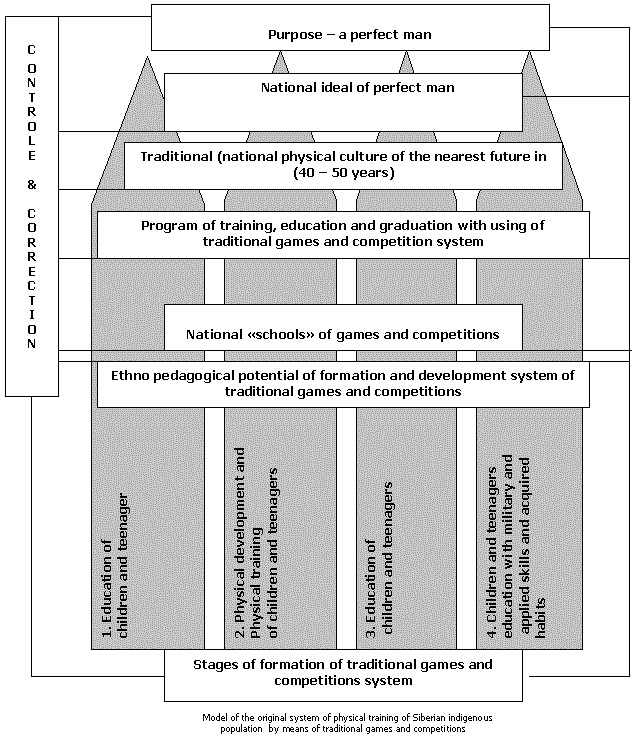
In the picture we can see the purposefulness of all original system of physical training to a highest level of model - to an ideal of the perfect person. At the same time Siberian indigenous populations have a national ideal which can not coincide with hypothetical (theoretical) or scientifically-proved ideal. The national ideal of the perfect person was formed during many centuries from generation to generation, that is well reflected in ethno-pedagogical researches, records, bylinas, legends, religious practices etc. He may be a national hero from epic legends.
So, for example, in Chukchis', Koryaks', Yukagirsks' and Ittelmeskychs' legends we can find an epic hero (bogatyr) who constantly trains, shoots from a bow, throw a spear, practices in running and carries huge weights. If the hero does not reach perfection in these exercises or throws it, he is doomed to death (Antropov, 1957).
There are bases to consider, that revealing of outstanding qualities of the soldier-hunter occurred at public assemblies of Chukchi, "young men permanently practiced in shooting, and at each public assembly there were competitions, when the winner received the prize which has been hung up about the purpose". The legend "Viyutku-predvoditel (leader)" tells us, how after the general doctrines were arranged special games: runners competed in run, fighters - in struggle, in rising of weights, and spearmen in a throwing of spears on the target (Bogoras, 1899). In such examples the ideal of the person to which should be imitated is becoming visible.
For disclosing the maintenance of model it is necessary to show genesis of traditional games and competitions: stages of its formation; national "schools" of training and education by means of traditional games and competitions; ethno pedagogical potential and mechanisms of traditional games and competitions system formation; the program of training, education and education by means of traditional games and competitions. Now we shall consider in more details all levels of the model construction.
Preliminary researches have shown, that a general (red) line through all structure, or maintenance of the model pass the basic functions of traditional games and competitions (it is designated by vertical arrows):
education of the person, including religious;
physical development and physical preparation;
formation of rising generation;
development of military and applied practices and skills.
Studying of the special literature specifies presence of four stages of traditional game becoming and development of.
It is necessary to allocate the 1st stage - the initial stage (the period from the Stone Age till arrival of Russian people to Siberia in the beginning of XVII century).
Archeological finds, heroic legends and bylinas, pictures of cave people, and also notes of travelers, scientists-ethnographers and even exiled people tell us that at this time among indigenous population of Siberia the system of traditional games and competitions with a view of physical training, military and labor training (mainly to crafts such as hunting, reindeer breeding, fishery) of children, teenagers, youth and adult population was widely applied. Physical training passed in conditions of primitive-communal, patrimonial system. But it is necessary to mention, that with arrival of Russian it has disappeared a necessity of military actions inside the indigenous population of Siberia because of Russian military leaders (voevody) have been stopping of different collisions between various Siberian ethnos. Physical training was reoriented on preparation for crafts, conducting housekeeping. But traditional games and competitions remained popular among Siberian indigenous population. There are such well known scientists and travelers who have written about it: Veniaminov, 1840; Zuev, 1947; Krivoshapkin, 1863; Finsh and Brem, 1882; Shrenk, 1903 and other.
At 2nd stage - transitive stage (the period from XVII century to construction of the socialist state RSFSR, later the USSR).
This stage is connected with settling of Siberia, extraction of minerals, collectivization. After October revolution indigenous population of Siberia has been incorporated in collective farms. The state has borrowed in education of rising generation. The program of physical training for national schools of the North has been created (Gurevich, Kagan, 1935). The articles and methodical recommendations on traditional games of indigenous population of the North have been published (Menovshikov, 1959; Leontiev, 1960; Rainson-Pravdin, 1944). But, nevertheless, children the most part of a season have been torn off from parents and native homes. It has led to interruption of centuries-old traditions in the field of original physical training and to attempts to impose the European system of physical training for indigenous population.
3rd stage - present stage of development (from 50-60 years of XX century till nowadays) is characterized in its initial part by transition to the "European" school programs of physical training and oblivion of national systems of physical training. All this, undoubtedly, has affected on calisthenics, physical development of the indigenous population of Siberia. In so-called "perestroika time " (the end 80th, 90th of ?? century) in connection with disintegration of the USSR and creation of the Russian Federation, the indigenous population of Siberia have got an opportunity for revival of national physical training traditions. Systematic researches of ethno pedagogic of physical training have been started; new programs for physical training for national schools, boarding schools, sports clubs, and sports schools of national kinds of sports have been created. Especially noticeably it occurred in Khanty-Mansiysk, Yamalo-Nenetsk autonomous regions, in Yakutia.
4th stage - stage of "future" connected with conditions of scientific and technical revolution, urbanization, deterioration of ecology. In this time (from present time up to 40-50 years of XXI century) we see the necessity of creation and arrangement of reserves with a view of preservation of original, native culture, but at the higher level. The most important is obligatory preservation and development in training and education of rising generation if Siberian indigenous population of such traditional games and competitions as races on reindeer and dog teams, races on a deer, equestrian sport, throwing of a lasso on a polecat, jumps through sledge, shooting from the bows, throwing of an axe, run with a staff, pulling of a stick, etc. Modifications are quite possible also: races on "burans", automobile rallies (with special wheels in difficult to traverse taiga places and even tundra). It is possible with inclusion of national kinds of sports of indigenous population of Siberia in the international competitions (the World championships, Asian and Olympic Games).
The first level of model which was examined on an example of the analysis of traditional games and competitions allows defining the time stages of development of indigenous population, to show periodicity of such development, necessity of deeper analysis of formation of their physical training.
The system of traditional games and competitions of indigenous population of Siberia contains rich ethno pedagogical potential. The history of the native population of this region for many centuries which have been described by various scientists has reported till the contemporary period the philosophical reasoning and approaches on lives, religious and communal views for a life of the nationalities occupying the North of Russia.
We consider that the main achievement of the Siberian ethnos is invaluable experience of preservation of health and a survival of people in extreme climatic conditions. From the given positions it is possible to analyze ethno pedagogical potential of becoming and development of traditional Siberian games and competitions.
The religious-philosophical doctrine or popular wisdom which is passing from father to son lays in a basis of any game. The shaman and the leader of a tribe (the elder and wiser men) formed the general direction of all activity of a clan, a community, family or concrete person. For example, a worship for the god formed the fear, and through it - becoming of uniform discipline and obedience of all members of a tribe or a clan.
Getting food, struggle against elements, protection against attacks of hostile nationalities, illnesses and hunger, various epidemics are the common episodes of Siberian everyday life. So, successful ability to live and struggle with adversities are possible only in conditions of strict discipline, submission to the elder, the collective help of each concrete person. At the same time, traditional games and competitions always were the main means, forms and methods of training and education.
Our researches have shown that traditional games and competitions accompanied the indigenous population of Siberia during all life (from a birth to death). So, for example, at Surgut Khanty have had games and competitions during "the Bear holiday"; Evenky have had competitions in struggle, games in a ball and splinters during funeral ritual (Krasilnikov, 2002, Lebedev, 1977). The Chukchi have had reindeer races as a part of ritual on a Fire sacrifice holiday and run holiday's occasions (on the last, besides, they have had a competition in speed and the winner was considered the most endurance). For seasonal ceremonies of seaside Chukchi it was most typical to run for the speed and throw up on a walrus skin. Koryaki during winter holidays also practiced reindeer races, struggle, and throw up on a walrus skin (Antropov, 1957).
These approaches allow proving that the direction of religious-philosophical doctrines forms and organizes only those games and competitions which are necessary at each concrete stage of development of indigenous population of Siberia with the purpose of education of the devout and obedient person. At the same time, all other parts of education, physical development and readiness are submitted to ritual and religious sections.
For example, fear of the god of water leads up to human victims. When Khunt, casually having got in water, he does not try to be rescued at all though he can easily make it because his traditional clothes do not become wet within 2 or 4 hours. Khunt is afraid of water and lies without movement, and then drowns because it is god's willing (Krasilnikov, 2002).
Some Northern people's games connected with shaman are constructed with religious education.
The other basis of formation of system of traditional games and competitions is folklore (basically the heroic epos, legends, and fairy tales). For example, the folklore of northeast nationalities of Siberia brightly draws an image of an ideal Bogatyr (russian Hercules). In Chukchi, Koryak, Ukageer and Itelmen legends a bogatyr all time trains, shoots from the bow, throw a spear, practices in run, carries huge weights. If the warrior does not reach perfection in it or throws exercises it is doomed to destruction (Bogoras, 1899).
The hero of Itelmen legends only defends by the bow from arrows; highly jumping up, when himself starts to shoot, he "couples" attacking - punches one arrow at once a two persons (Antropov, 1957).
Similar features allocate an ideal image of the hero-warrior in Ukageer folklore. He possesses the big physical strength so that he can one can battle to the whole group of enemies, defend, catching the arrows directed to it or jumping up so high, that arrows cannot pierce it: "On Lamut heads jumping (he) battled" (Antropov, 1957).
The epos transferred from generation to generation is the main potential of origin, occurrence and development of games and competitions of the Northern indigenous population.
The following level of the model allows seeing national schools of physical training. The analysis of references, our field ethno pedagogical researches in the North of Siberia allow to allocate following kinds of schools: "maternal", "family", "communal", "patrimonial" (Krasilnikov, 2002).
"The maternal school" covered children in the age of from a birth till 5-6 years. In this period in education mother exclusively was engaged. She made toys for games, learned children to game rules with it.
In the age of 6-7 years there was a separating of children. In education of boys the father started to learn, and the mother taught the girls. This period is allocated by us as a "Family school". The father made for sons hunting and fishing equipment (bow, arrows, skis, boats and etc). Girls received from mothers' accessories to sewing clothes, boots etc. Parents arranged with children games and the competitions connected with hunting activity at boys and housekeeping at girls. Boys started to take on hunting, fishing, to involve pasturing of deers, livestock. Girls started to join in economic activities. Except for industrial purposes, traditional games and competitions promoted development of the vital physical qualities, training to impellent skills, and also education of moral, collectivism, spirituality.
At training in "communal" and "patrimonial" schools teenagers were trained in skills of collective hunting and military science. Besides it, the management in the military training was spent not only by family, but also by the clan. The oldest warriors became instructors of young men. In the legend "Vijtuku- the Leader" Eskimos have been preparing for a military campaign, men and young men had got specialized training preparation under the supervision of their leader Vijutku and his two brothers (Bogoraz, 1899).
At Koryaks in olden time during competitions on holiday's warriors of various settlements attentively studied force and ways of struggle with each other to make use of the extracted experience in case of occurrence of the real war. (Antropov, 1957).
Similar games and competitions were at Ukageer natives. On interpatrimonial assemblies "time was spending in competitions and games". Warriors of various patrimonial groups were supposed to competition, at the same time some of games also have had military character (Antropov, 1957).
The role of the old generation in military preparation is traced in many legends of Siberian indigenous population (Krasilnikov, 2004).
All original people of Siberia have harmonious system (schools) of education of rising generation by means of traditional games and competitions. At all variety they bore in themselves the concentrated, invaluable experience of a survival in heavy for existence climatic conditions which is constantly transferred to the rising generation.
The considered ethno pedagogical potential allows passing to the higher level of the model, connected with disclosing of pedagogical mechanisms of formation of various physical exercises of people of the North in which basis the orientation of all system to a national ideal of the person overcoming severe climatic and geographical difficulties of region is lying.
Indigenous population of Siberia use the traditional games and competitions in which the emphasis is done for its role and functions (educational, teaching, influence on physical development and readiness, and also applied value of physical exercises for a life of people) as the main means of physical development of the person.
Origin and formation of physical exercise starts with experience of people and necessity of movement or game for an ultimate goal - carrying of impellent action to practice and applied value for the future life.
At the same time, the complete movements in games are broken into components and parts consist of the bringing exercises, separate elements, part or whole impellent action also. In this connection traditional games and competitions can be classified on: bringing games, preparatory games, complete games or games-competitions.
For example, the throwing of a lasso on deer horns is the important professional skill. And the given impellent certificate is taken in used games to pieces.
As an example of shown above structure of traditional games and competitions the game with a throwing of a lasso on deer horns can be specified. Bringing games are games with children in throwing of the truncated lasso on socks of sledge, on branches of trees, on the little stakes specially hammered into the ground, on suspended on a cord block, etc. It is possible to consider as preparatory games - games with a throwing of an adult lasso on a trochee, on range, on accuracy of a landing, on the sitting or costing person, on running players. And complete games or games-competitions are throwing of a lasso on a trochee in competitive conditions (who will make exact throws more), a throwing of a lasso on players ("deers") running on a play platform.
It is possible to carry to preparatory games: a throwing of snowballs in the aim, throws of rings on branch of tree or a stick, pulling of a stick by two hands sitting on the ground, run, walking (Krasilnikov, 2002). It is possible to trace origin and formation of complete movement on games when the reindeer breeder catches from herd by exact throw of a loop of a lasso on horns of a deer.
The pedagogical mechanism of occurrence and formation of impellent actions is connected with logic sequence (necessity) of mastering by that or other impellent skill which has passed check by centuries-old experience of a life of northern people. Since early years, with the help of bringing games children have got the unstable dynamic stereotype to performance of concrete movement. Preparatory games promote the further exercise (numerous recurrence), at the same time at the child or young men in complex interaction of the central nervous system and the nervously-muscular device are formed some steady dynamic impellent stereotypes which provide stability of game actions. Such gradual sequence of use of various games allows forming of complete impellent action in the further complete impellent actions are fixed directly in games-competitions on various holidays, for example, "who will more quickly catch a deer by means of a lasso" and in military operations.
The dosage of loading in preparatory games easily steals up both for children, and for adults due to duration of game, quantity of repetitions, the periods of rest. The emotional background is supported due to use of competitive activity of children or adults.
The program on physical training for preschool establishments should contain the traditional games connected with national crafts such as board games with dolls, with stones, threads, duck noses, deer bones, whirligig, a top etc.
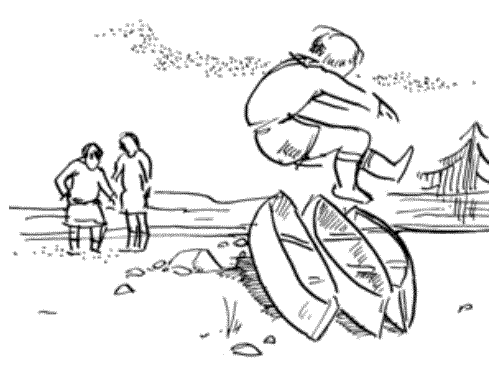
In the further in process of growth it is possible to train children to their outdoor games: "hide-and-seek", "catching", running, throwing of rings, etc.

It is necessary to include such specific games and competitions as "the throwing of a lasso on a trochee ", "jumps through sledge", "pulling of a stick", "races by boats", "shooting from bow in aim ", "shooting from bow on range", "Gorodki" and so on in variety part of the program at secondary schools.
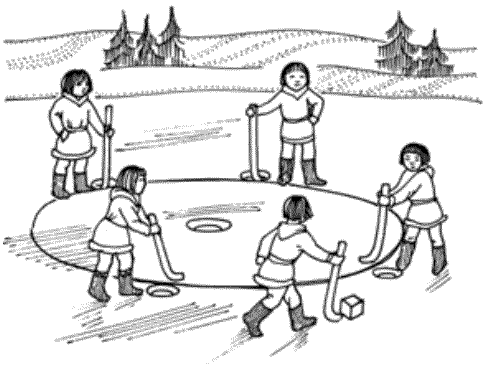
Besides in outside of school hours we can recommend to cultivate sports sections with national kinds of sports.
In higher educational institutions it is also possible to fill in variety a part of state standard with national kinds of sports, outdoor games, games-competitions, northern multiathlon.
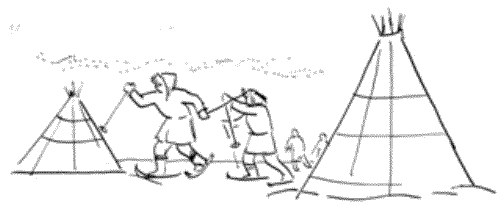
In the presented work the model and the conceptual positions reflecting the process of becoming and formation of system of traditional games and competitions of indigenous population of Siberians are formulated. The physical culture of people of Siberia contains an unique and invaluable experience of a survival in severe climatic conditions of the North of Siberia, and also the opportunity to live in harmony with the nature and once again specifies that the future of mankind is in preservation of cultural variety, the careful attitude to the nature and ecology as a whole.

Carried out researches allow us to look at the nearest future for 40-50 years to consider the influence of various factors on development of northern regions of Russia, and together with it at formation of a cultural heritage of people. During the present period there is a gradual urbanization, and together with it the assimilation of Siberian nationalities with Russian nation. Indigenous population of Siberia gradually loses their national culture, and the oil, gas and chemical industry masters all new and new territories.
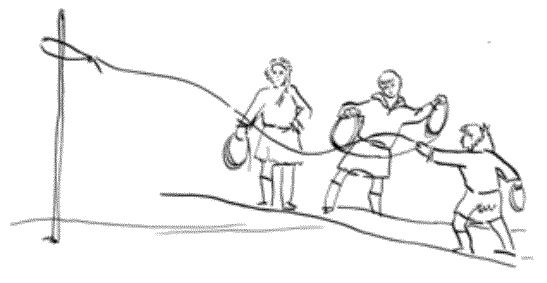
It is necessary to develop the general direction of preservation and development of national physical training which will allow avoiding mistakes of last time.
In the nearest future in connection with an exhaustion of stocks of hydrocarbons and occurrence of alternative energy sources, northern territories will become zones of natural reserves in which will live radical peoples. In such zones ecological craft and the reindeer breeding necessary for ability to people's living will be developed. Mainstream of ability to live is reindeer breeding, manufacture of ecologically pure food raw material (deer, fishes) and also a local craft, manufacturing of skins of deers, manufacturing of souvenirs and various national clothes. Through regions will pass tourist routes, and also extreme-tourism routes, making a profit for local residents. The image of northern inhabitants will change into educated person with a mobile phone and the Internet.
We consider that traditional games and competitions can be that link between culture of the past, the present and the future not only of indigenous population of Siberian region, but also of other people which aspire to find a way out of an increasing urbanization, industrialization and infringement of ecology of a planet.
References
Antropov V. (1957) Questions of the military organization and military science at people of Extreme Northeast of Siberia // the Siberian ethnographic collection. Vol.2. Pp. 238-260.
Bogoraz V. (1949) Games of small nationalities of the North // The Collection of a museum of anthropology and ethnographies. Moscow. Vol. 11. Pp. 237-254.
Bogoraz V. (1901) Sketch of material life of deer's Chukchi, made on the basis of N.L. Gondatti collections // The Collection of a museum of anthropology and ethnographies. SPb., Vol.2. P.27-28.
Bogoraz V. (1899) Legend about Elendi and his sons // Alive oldies. Vol. 3. Pp. 361-365.
Veniaminov I. (1840) Notes about Unalash section islands. Saint-Petersburg, Part 2-3.
Gur-Gurevich V., Kagan G(1935) Physical culture in national school of Extreme North / Educational program. M.,-L.,.
Zuev V. (1947) Description of heterodox peoples> - Ostyak and Samoed - living in Siberian province Berezovski district (1771-1772) . Moscow-Leningrad: Publishing house of Academy of Science. USSR.
Krasilnikov V. (2002) Games and competitions in traditional physical education of Khanti. Ekaterinburg,. P.120.
Krasilnikov V. (1994) and others. Games of Khanti // Physical culture at school. Moscow
Krasilnikov V. (2003) The problems of specialist training in physical culture and sport for Ural-Siberian region // Perfection of cadre preparation in physical culture and sport in condition of modernization of vocational education in Russia: Conference thesis. Moscow, March, 13-14. 2003. 234 p.
Krasilnikov V. (1993) The role of traditional games in physical education of the Khanti's rising generation // Problems of physical education in schools of Sakhalin region. Thesis report of science-practical conference. Khabarovsk, April, 18-20, 1993.
Krasilnikov V. (1993) Traditional means of Khanti's physical education // The Seventh Vinogradov's readings: Thesis report of science-practical conference, Ekaterinburg, June, 14-17 1993
Krasilnikov V. (1998) Folklore and national traditions in physical education of Siberian children // Place and meaning of folklore and folklorism in national cultures: history and the present. Chelyabinsk
Krasilnikov V. (1995) Ethnopedagogy's conditions of using of Khanti games and competitions // Theory and history of games. Moscow.
Krasilnikov V. (1994) Ethnopedagogy's conditions of using of Khanti games in traditional physical education. Abstract of Dissertation of candidate of pedagogical sciences / Ural State Pedagogical University. Ekaterinburg, 18 p.
Lebedev V. (1977) The funeral ceremony of Achaivayams Koryaks reindeer-breeders. The fields researches by Institute of ethnography. Moscow
Leontiev V. (1960) National games of Chukhi // On the Far North (Literary-artistic miscellany ), Magadan: Magadan publishing house.
Menovshikov G (1959) Eskimos: science popular historical ethnographical essay about Asian Eskimos. Magadan
Rainson-Pravdin A. (1944-1945) The game and toy of Obsk northern people: Dissertation of candidate of historical sciences. Moscow -Leningrad.
Finsh O., Bram A. ( 1882). The travel in West Siberia. Moscow.
Shrenk L. (1903) About Amur regional non-Russians. Saint-Petersburg, Vol. 3.
 |
|
|---|---|
|
revista
digital · Año 11 · N° 102 | Buenos Aires,
Noviembre 2006 |
|